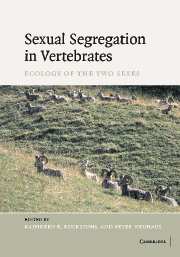Book contents
- Frontmatter
- Contents
- List of contributors
- Preface
- Part I Overview
- 1 Sexual segregation and the ecology of the two sexes
- Part II Concepts and methodology
- Part III Foraging ecology
- Part IV Predator avoidance and reproductive strategies
- Part V Sex-related activities and social factors
- Part VI Sexual differences in ecology: comparisons within different taxa
- Part VII Implications for conservation
- Part VIII Outlook
- References
- Index
1 - Sexual segregation and the ecology of the two sexes
Published online by Cambridge University Press: 04 September 2009
- Frontmatter
- Contents
- List of contributors
- Preface
- Part I Overview
- 1 Sexual segregation and the ecology of the two sexes
- Part II Concepts and methodology
- Part III Foraging ecology
- Part IV Predator avoidance and reproductive strategies
- Part V Sex-related activities and social factors
- Part VI Sexual differences in ecology: comparisons within different taxa
- Part VII Implications for conservation
- Part VIII Outlook
- References
- Index
Summary
According to Greek mythology, Amazons were female warriors who lived on an island. They occasionally met with men of another people to mate, keeping female offspring and sending male offspring back to their fathers. In many animals too, males and females live apart for most of the year, only gathering for mating. These include many fish species (Sims et al., 2001a), birds (Myers, 1981), lizards and snakes (Parmelee & Guyer, 1995; Shine et al., 2003a), and most mammals with a pronounced sexual dimorphism in body size (Ruckstuhl & Neuhaus, 2000). This book aims at synthesizing our current understanding of the evolution of sexual segregation in different vertebrates, focusing on taxa in which there is sufficient evidence to investigate causes of sexual segregation.
Sexual segregation has caused confusion in the literature, as it can occur at different levels (see Chapter 2 for details). Why, for example, do house mice, Mus musculus, embryos segregate by sex in their mother's womb (Terranova & Laviola, 1995)? Why do African ground squirrels, Xerus inauris, live in separate male and female groups within the same area (Waterman, 1997)? Why do female dogfish, Scyliorhinus canicula, use different feeding and resting areas than males (Chapter 8)? Or why do humans prefer to socialize with same-sex peers (Chapter 12; Maccoby, 1998)? Some species show social segregation of the sexes: males and females are found in different groups outside the mating season, but use the same areas and habitat types (see Chapters 9 and 10).
- Type
- Chapter
- Information
- Sexual Segregation in Vertebrates , pp. 3 - 8Publisher: Cambridge University PressPrint publication year: 2006
- 7
- Cited by



